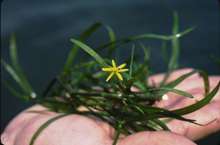Heteranthera dubia
Heteranthera dubia is a species of aquatic plant known by the common names water stargrass and grassleaf mudplantain. It is native to North and Central America where it is widespread from Canada to Guatemala. It lives submersed in freshwater such as rivers and lakes. It is quite variable in appearance. The leaves are different sizes and shapes across individuals, partly genetic variation and partly response to water conditions, for example, the speed and turbulence of surrounding currents. Submersed individuals also have a different stem and leaf morphology from those that occur partially or completely out of the water. The inflorescence bears a single short-lived flower that blooms in the morning and wilts in the evening. It has six yellow perianth parts each less than a centimeter long spreading from a tubular throat one to seven centimeters long. There are three long, thick yellow stamens with curling anthers and one yellow style. The fruit is a capsule containing many winged seeds. The plant sometimes has galls in its tissue, which are caused by the parasitic fungus Membranosorus heterantherae.
| Heteranthera dubia | |
|---|---|
 | |
| Scientific classification | |
| Kingdom: | Plantae |
| Clade: | Tracheophytes |
| Clade: | Angiosperms |
| Clade: | Monocots |
| Clade: | Commelinids |
| Order: | Commelinales |
| Family: | Pontederiaceae |
| Genus: | Heteranthera |
| Species: | H. dubia |
| Binomial name | |
| Heteranthera dubia | |
| Synonyms | |
|
Heteranthera graminea | |
References
External links